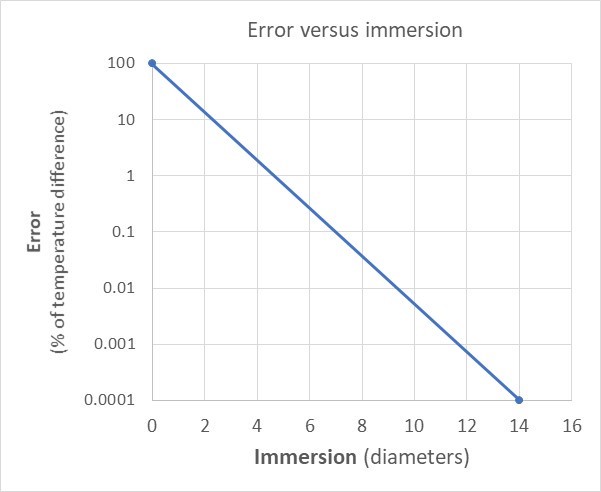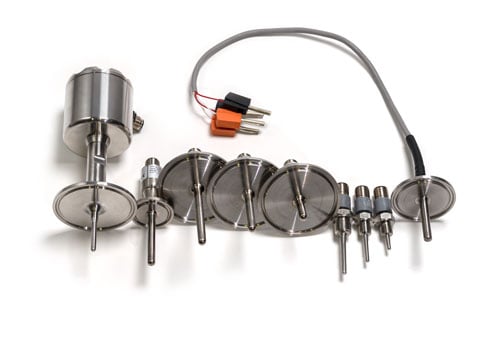1. Sensors are very short
As mentioned earlier, these sanitary temperature sensors are typically very short. Most often less than 100 mm (4 in), typically around 50 mm (2 in), but can also be as short as 25 mm (1 in).
The outer dimension of the sensor typically is 3 mm (1/8 in) or 6 mm (1/4 in).
The commonly used practice in temperature calibration (and an Euramet guideline recommendation) is that a temperature sensor should be immersed deep enough to achieve sufficient accuracy. The recommendation is to immerse into a depth that is 15 times the sensor diameter (plus the length of the sensor element). But with these short sanitary sensors, it is simply impossible to immerse the sensor into sufficient depth during the calibration, because the sensor is so short compared to the diameter.
For example, a typical sanitary sensor with a diameter of 6 mm (1/4 in) should be immersed (15 x 6 mm) into at least 90 mm (3.5 in) depth during the calibration, to ensure accurate results. But if that 6 mm (1/4 in) sensor has a length of only 50 mm (2 in), sufficient immersion is simply not possible.
When not immersed deep enough, additional error and uncertainty will be caused in the calibration.
our temperature calibration lab people gave these rules of thumb for the immersion depth (when calibrating in liquid bath):
1% accuracy - immerse 5 diameters + length of the actual sensing element inside the sensor
0.01% accuracy - immerse 10 diameters + length of the sensing element
0.0001% accuracy - immerse 15 diameters + length of the sensing element
The “accuracy” in the above rule is to be calculated from the temperature difference between the block temperature and the environment temperature.
Example: if the environment temperature is 20 °C and the block temperature is 120 °C, there is a 100 °C difference. If you then immerse the probe only 5 times the dimension (plus the sensing element length) – say you have 6 mm probe with a 10 mm sensing element inside of it - and you immerse it 40 mm (5 x diameter + sensing element) - you can expect about 1 °C error due to the low immersion (1% from 100 °C).
Picture: The below picture illustrates the commonly used relationship rule between thermometer immersion depth (in diameters) and the relative error of the temperature difference (of the temperature block and environment temperatures). So if you don't immerse at all, you naturally get a 100% error, and if you immerse deep enough the error caused by immersion becomes insignificant. Somewhere around where the immersion is 5 times the dimension, the error is about 1% of the temperature difference:

This rule of thumb can become quite significant at higher temperatures and/or for extremely short sensor lengths. So, keep this in mind with sensors less than 40 mm or 1-1/2 inches. Also, it may be worth having a conversation with a design engineer to figure out a way to increase the sensor length.
Naturally this accuracy limitation is valid also when the sensor is installed in the process and measuring the process temperature - being too short, the sensor is not able to accurately measure the process temperature!
It is not always easy to know the length of the actual sensing element inside the probe. If that is not mentioned in the datasheet, you can ask the manufacturer.
So how to calibrate these short sensors that can not be immersed deep enough?
This will be discussed in later chapters.
2. Sensors often have a clamp connection with a flange
As mentioned in the previous chapter, these sanitary sensors are too short compared to their diameter to enable a proper immersion causing temperature leaks, adding error and uncertainty to the calibration.
Like this would not be enough, these sensors also often have a so-called clamp connection (Tri-clamp, ISO 2852, DIN 11851, DIN 32676, BS 4825, Varivent, etc.) configuration, so there is a relatively large metallic flange, that is causing temperature to conduct / leak from the sensor to the flange. In practice, this temperature leak means that the temperature from the sensor is conducting to the large metallic flange, so the flange causes the sensor to read a bit of a lower temperature (when calibrating temperature higher than environment temperature).

this kind of flange makes the calibration more difficult is several ways:
First, the flange adds temperature leak from the sensor to the flange, the more the bigger the flange is, the more the bigger the temperature difference is to the environment temperature.
While at the same time the sensor is very short, this temperature leak causes the sensor to measure erroneous temperature.

















